
The outward appearance of the gluteal group, particularly our grand gluteus maximus, causes as much pride as consternation in our culture than perhaps any other muscle set. The truth is, the muscles that make up this key cluster at the posterior of our bodies deserve to be honored for the amazing work they perform for us everyday-regardless of their outward appearance.

There are several muscle sets located at the hips, and we’ve met a few of them in previous Yoga Tune Up® blogs, including the Tensor Fasciae Latae and the Piriformis. Here we will examine the gluteal group, and the Yoga Tune Up ® exercises that can provide flexibility and strength to this area. We will discover that one common result of tightness and over-training of this group of muscles is once again low back pain, and limitations in one’s yoga practice as well. As usual, inordinate amounts of time in any activity: sitting at work, riding the bicycle, the horse, or even running, creates imbalances through under or over use.
In yoga, as in life, symmetry, equanimity, and the realization that the impact of our actions will reverberate throughout our being can motivate us to become more aware and conscious. In this case, let’s raise glute consciousness.
The three muscles of the gluteal group are Gluteus Maximus, Medius, and Minimus. Their names reflect the size of the muscle, and somewhat indicate their location from superficial (maximus) to deep (minimus).
Gluteus Maximus
The strong gluteus maximus is closest to the skin’s surface. It’s work is to extend the hip. For example, when taking Warrior I in yoga, it works with the hamstrings to extend the back leg. This muscle also externally rotates the hip, and helps to move the thigh away from the body (abduction).
Now, we wouldn’t want to continue discussion the gluteal group without acknowledgement of the padding and insulation in the buttock area. This padding and insulation is called adipose tissue, and by and large this tissue (otherwise known as um, fat) is necessary and a good thing, in moderation. (For recent information on the advantages of the “pear” shape see): http://www.sciencedaily.com/releases/2010/01/100116104535.htm
So as we discover our glutes, you’ll also encounter your adipose…tissue. Stand with your feet hip width apart, take a giant step back as in a simple lunge or Warrior I. Place your hand on the buttock of the back leg. You should feel the gluteus maximus contract.
Gluteus Medius
The gluteus medius is located more to the upper outer part of the hip. It is partially covered by the gluteus maximus muscle. The Gluteus Medius is crucial for stabilizing and equalizing, or as we say in Yoga Tune Up®, joint-stacking our hips. The classic side lying leg lift exercise helps to target and strengthen the gluteus medius. In yoga, the back leg in triangle also activates the gluteus medius.
Gluteus Minimus
The Gluteus Minimus is situated beneath the gluteus medius. The minimus stabilizes our hips, rotates our thigh inward, and also abducts the hips. Some of these yoga poses to strengthen glutes are opposite of the gluteus maximus, but the gluteal group is so large that it can work in many different directions to keep the hip in harmony.
Wake Up Your Gluteus Medius
For a wonderful awakening of the gluteus medius, practice the Yoga Tune Up® pose Leg stretch #3.
And remember to appreciate your glutes for the functions they perform for us in everyday activities!
Watch our Free 5-Minute Quickfix: Hips Video
Learn about our programs to relieve hip pain.
Learn about our Therapy Balls Program for your lower back.


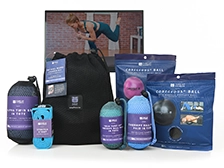
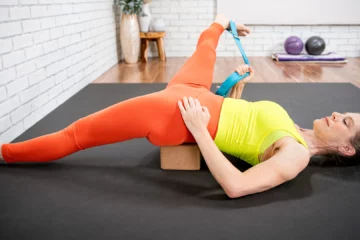
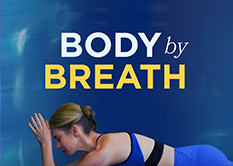
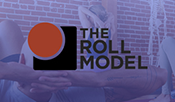
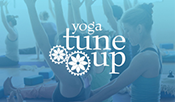


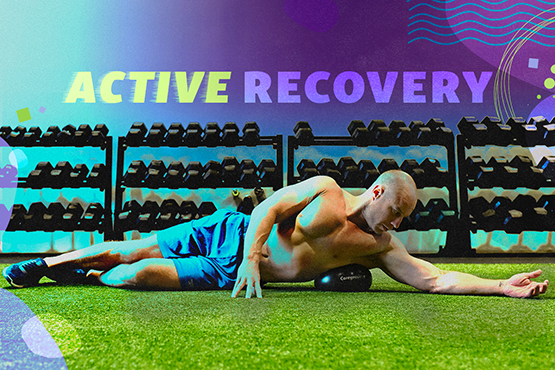
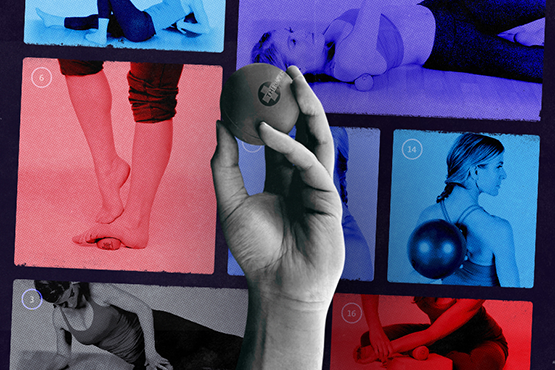
Very clear and informative information about the gluteal group. I have plenty of adipose tissues good to know I should appreciate it’s insulation.
Thanks for sharing! Completely agree that these 3 muscles are important to get to know and not neglect.
‘Back leg of triangle pose target the gluteal medius’ Finally I know which part of gluteal I’m working on the pose. After reading this article, learn the importance of gluteal medius related to pelvis stability. Now is the time work on yoga tuneup pose leg stretch #3
Thanks Bonnie, this was helpfull and very clear!
This blog was so helpful!! you taught me about the ‘adipose tissue!’ I was wondering what I could call that area and what is actually in there, and all I could come up with was ‘gluteal meat.’ hahaha, Okay, now I know! Thank You!
Thank you for the detail article about the glute muscles. This is such an important muscle group of the body, so many people are walking around with glute amnesia. Considering that gluteus maximus is the largest muscle in the body, it shouldn’t spend so much of it’s time being turned off. If more of our older population continued to strengthen their glutes they would he able to continue an increased quality of life.
The gluteus group is my most favorite muscle group! It has so much potential to align the entire body. They have so many muscle actions that we don’t realize! Thank you for this!
Thanks for this article! I’ve found that a combination of Yoga Tune Up exercises and Pilates have really helped my proprioception of the gluteus group. I’ve been practicing yoga for over a decade, with minimal awareness of my glutes before discovering YTU and pilates.
Thanks for this article & providing some clarity into the separate roles & functions of the glutes. It is rare in a general yoga class environment to really hear their separate locations & jobs differentiated, rather than just referenced in passing as one synonymous group.
Thanks for your explanation of the location and different actions of each of the gluteal muscles. often we lump them all together – now I will put emphasis on isolating and strengthening each part of the muscle group separately.
Our Glutes get weak just by sitting too much. I normally have an anterior tight to my pelvic but sitting for prolong periods of time causes back pain and my pelvis immediately posteriorly tilts and it take me 5-10 minutes before I’m fulling standing upright again. I need stronger glues and better posture while it, should we engage our glutes while we sit?
Thank you for the detailed explanation of the glutes. When i learn how to engage my glutes in various poses such as cobra, worrier, and chair poses, I feel the pose becomes more powerful. I also started to pay attention to glute activation in walking. Strong and supple glutes are good support for the lower back.
glut muscles are so often weak due to all the sitting we do and most often even imbalances are there between the 2 sides. More attention to the gluts and rebalancing them is something most people can use. thanks for the attention on the subject!
Thank you for your detail about location and the relationship via depth. I appreciate this article!
It’s so true that excessive amounts of time in any activity (in my case sitting at a desk for work) creates imbalances in our body, mind, and life and can motivate us to become more aware and conscious! I appreciate your explanations for the directions of movement of the gluteal muscle. I recently discovered in my YTU Level 1 training, while doing a similar exercise to activate the gluteus maximus to the one you described in your post, that my right gluteus maximus is much weaker and less toned that my left gluteus maximus. I’m not sure why this is, but I imagine it is related to the excessive sitting that I do. I wonder too if I might sit more on one glute than the other? As a result of this imbalance discovery I will now pay closer attention to my glutes when sitting and am motivated to strengthen the right glute!
Thank you for shedding some much need light on the role that each of three gluteal muscles take in movement of the body. It has given me a new appreciation of how nest to prepare my fellow yoga students for the more challenging one legged balances and for the proper gait for my beginners when practising tree pose.
Just read a more recent article by one of our fellow YTU’rs and it stoked my interest in learning more about the gluteal muscle group. Thank you for touching on the difference between the functions of the Maximus, Medius and Minimus muscles.
Thanks for breaking down the glutes! As a beginner learning anatomy, I loved the pictures and being able to see each of the different muscles side by side. I wish I would have known the importance of the glutes earlier in life as I heard that underdeveloped glutes are one of the (many) reasons for ACL injuries.
Thanks for reprinting this article, but unfortunately, the final links don’t work. 🙁
What I love about this article is that it reminds us of the importance of not just to strengthen our glutes, but then to go ahead and lengthen them them through the leg stretch series. So often we are tempted to rush through a workout and really neglecting the importance of stretching.
i just did a YTU Therapy Ball presentation today affecting the glutes but completely overlooked the gluteus minimus. i even told the class that the gluteus medius was responsible for abducting the hip! i need to hit the books and study some more. thank you for sharing this.
[…] Tune Up® Blog « Get to Know Your Glutes Relief from Fibromyalgia with Yoga Tune Up® […]
Thanks for dissecting the glut muscles for Bonnie. I’ve been dealing with a chronically tight periformis and this article has reminded me I need to activate/ and tone my glutes in order to help release my periformis.
Julia
Hips in harmony! Hip, hip, hooray! Until reading the YTU manual and some the YTU blogs, I actually didn’t realize there was such an obsession with the glutes. Honestly, I look in the mirror, back view, before I go teach in case anything has ripped… I have probably underused my glutes and most of my body my whole life. I am learning so much about these muscles know and the importance of keeping them strong and flexible. I will say I’m proud to be a teacher that demands glut use and blocks between the inner thigh in bridge pose. The minimus so so tiny and so hidden yet it helps abduct and rotate the hips as well as stabilize the hips. I hope I never become obsessed with my glutes BUTT I do hope I become an expert on the anatomy of the glutes so I can share it with my students. I am a student of what I teach.
Hey Thanks. really liked how you explained the function of each Glute min,med,and max.
Thank you for this very informative article. It is very helpful as I’m in the middle of my Level I training with Jill. I got to know my glutes “very” well during our ‘Friday class’ template day. I thought it was amazing .So much work yet relaxing at the same time and my glutes weren’t in pain the next day. My entire lower body was very tight but not screaming at me. It was happy. YTU is the only system I’ve experienced that gave me the feeling of tightness without post-exercise pain.
Recently I have become more physically aware of strengthening my glutes, away from the normal squats, Usually during back bend poses, such as Dhanurasana and Ustrasana, I often focused on my abs/core to protect my lower back. More recently, after a weekend full of back bends, I noticed that my posterior top outer hip area became painful and tired when in Malasana. My research has concluded me to believe, the over use of my gluteus medius, in most of the back bends had really been the reason for the pain. I am wondering if a bit of rest will assist in the pain subsiding, it seems to work. I am in hopes that I am strengthening those glutes and not creating an injury. Feedback is appreciated. Namaste!
as a new student of anatomy, this article i very helpful to me in learning what the glutes do and how to strengthen them.
I’m learning about the gluts in a Yoga Tune Up Anatomy training workshop with Jill Miller. It is fascinating learning about the intricacies of the glutes (i.e maximus,medius and minimus and the fibers that run through them). I didn;t know that weakened glutes could contribute to lower back pain. Thanks for the information.
Thank you for the thorough explanation of the glutes. It is certainly surprising how much sensation pops up in my left gluteus medius while practicing leg stretch #3 and curious that the same sensation does not arise on the right. Ah, the quest for symmetry and equilibrium in the body continues.
I always need a reminder to thank my gluts! Thank you for this post. i have also found that combining hip openers with twisting helps alleviate lower back pain when sequenced and taught properly. And YTU Therapy Balls can definitely get into the lower back and hips in a very juicy, softening tissue way.
Thanks for the tour of the glutes. I hadn’t realized that the names reflect the size of the muscles as well as their position from superficial to deep.
A very informative and lucid article. Thanks. Ever since I have taken the YTU training, I have been inserting all the 3 leg stretches even more frequently than before in my class sequences. My yogi students too love this difference. The glutes are the natural cushion to our seats, and perform such important functions in walking running and practically many of our body movements, and yet, many a times don’t receive their due importance.
This article really points out how much we put our gluteal muscles to work — throughout our daily activities and in our yoga practice. That’s why it is especially important to stretch this group of muscles regularly. It was particularly interesting to learn that tight or overworked glutes can lead to lower back pain.
great article about this muscle group!
wonderful blog! this is in fact my fav part of the body to work out. chair pose really shapes the buns and the longer the pose is held the stronger the muscles get. great blog.
I didn’t realize that the padding and insulation called adipose tissue was part of the gluteal equation. I have recently heard the term yoga butt used to describe a healthy look to this area of the body. I understand the connection now.
I tend to experience pain or tightness in my low back from certain yoga poses and other workouts. I didn’t even think about focusing more on my gluts. Thanks!
This article really helped me understand this area of muscles. I will try YTU Leg Stretch #3 and think about these muscles next time I am in Warrior 1.
I did not realize that tight glutes contributed to lower back pain. Incorporating the leg stretch #3 after using the YTU balls will provide some wonderful relief at the end of the day!
Great article! Lots of information!
THis was a wonderful article. I have alot of pain in my left glut area. I also have low back pain. I can see how they are so closely connected. I’m going to work harder on stretching out the Gluteal Group! Thank you
Thank you for the information, there is a lot of it here.
I’m glad this article struck a chord with so many! Thanks for reading.
Yes, very informative article on explaining what the gluts actually do and keep the hip area working in harmony. I am so much more aware of my 3 Gluts…!!
This is a nice review of the glutes. And thanks for the link to the article – it was nice for us ladies to see a headline saying your big butt is going to help you live longer! Although, unfortunately it was interpeted by many that it was healthy to be overweight, as long as the the lower body was larger than the belly, which is not the case.
Great breakdown of how the glues work as a team in keeping the hips in harmony.
In addition to the news about unhealthy waist size, it is good to know that having a bit more junk in the trunk and wider hips are considered healthy
Questions from a curious beginner: how come there are not more poses that really target the gluts? In yoga classes, instructors rarely start out with this pitch, “this will make your butt look great!” Truth be told, my buns never burned very much in yoga classes (am I doing something wrong?). Do yoga practitioners look down on the proverbial “nice a–“? Or is it just all flattened from so much stretching?
This is a great briefer on these muscles, and I am thankful for the simple explanations of their role. I’m happy that I have a deeper understanding now, especially considering how society imposes such stark misconceptions and judgments to this area of our body!
Thank you for sharing such great information about the gluteal muscles. I had not realized that the gluteal muscles work in many different directions.
Thanks for all of your responses to this article!
@Donnette: In my experience, the balanced practice of Yoga and the amazing Yoga Tune Up hip exercises highlighted here will bring both strength and flexibility to many of the muscle groupss highlighted in these blogs. As you and your students practice, you will observe through their poses, and they will tell you what kind of focus will be particularly beneficial.
Thanks for the information. I love usine the Tune Up Balls on the glutes and it is important to know more about the areas I’m targeting. Susan
The gluteus maximus is often misunderstood. Many of the ladies avoid strengthen the glutes. They don’t want their buttocks to grow bigger and men pay more attend to the biceps. It’s important to have a strong and healthy gluteal muscles, They are hip extensor and abductor. They stabilized the pelvis & trunk to prevent injury.
With the wide range of movement the glutes provide to the hip, it is important to work these regularly. I find that in many of the standing yoga poses, the glutes help externally or internally rotate my thighs to provide the stability I need.
Is there a simple way to ascertain whether a person should focus more on creating further flexibility of the glute muscles vs. more focus on strengthening the group
What’s amazing about this is the number of actions and range of movement the glutes enable us to perform! Its strength gives us hip stabilization, contraction can tilt the pelvis and give us balance, tightening gives us external rotation of the femur at the hip… the list goes on and on. What a good muscle group to get to know – and appreciate!
Very informative article. I enjoyed the pictures and the reference to Science Daily!
Interesting and informative! This makes me more aware of how the layers of glute muscles are involved in many yoga poses.
I never really considered yoga to be a great butt workout but your explanation of the glutes activating in Warrior 1 helped me to visualize the muscle involvement as it relates to the back leg.
Great way to break it down! Thanks.
I didn’t realize so many common activities could affect the glutes!
the relationship of this muscle group to the hamstrings was a learning for me.
Very interesting!
Very informative. Helps to really understand the glutes.
They come in all shapes and sizes. I love mine! YAYY!
Good to learn about the Gluteus Medius